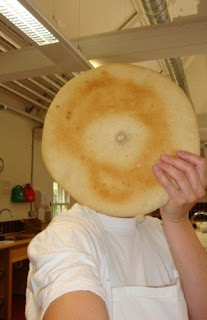Stottie recipe:
Strong white flour 1000g
Fresh yeast 30g
Salt 20g
Lard 40g
Water 550g (+/-)
Milk Powder (or replace the water with milk) 20g
Sponge 380g
Sponge recipe (make overnight):
Strong white flour 1000g
Fresh yeast 3g
Water 550g
Method:
1) Mix the sponge the day before and ferment for 18-24 hrs at ambient temperature.
 2) Mix the stottie dough by hand until well developed, soft and silky (like a babies bottom:) or you can use a mixer for 6-8 mins
2) Mix the stottie dough by hand until well developed, soft and silky (like a babies bottom:) or you can use a mixer for 6-8 mins3) Keep covered and ferment for 1hr
4) Scale dough pieces at 400g and round. Then cover and rest for at least 15mins.
 5) Roll out the dough to form a round disc of around 20cm in diameter and approx 1/2cm thick. Place on a baking tray and prove for 40-60 mins.
5) Roll out the dough to form a round disc of around 20cm in diameter and approx 1/2cm thick. Place on a baking tray and prove for 40-60 mins.6) Just before baking stick your thumb in the centre of the disc to dock and stop movement/rise whilst baking.
7) Bake for 10 mins if on a tray at 230 degrees or 8 mins if direct on the stone. Turn the stottis over about 2/3rds of the way through baking.
 |
| Serve as sliced wedges |



The stotties look my mum made during the war but I'm confused about the two recipes, is the sponge method a stottie cake!
ReplyDeleteIf I make a sstottie cake do I use the Stottie recipe only
Confused
Tom Bobbin
This recipe has been posted all wrond, it's a mess. It looks as if the "sponge" is the flour, yeast and water from the top part of the recipe, which are mixed together to make the yeast mixture, but the amounts are all wrong for a start. It says 3g of yeast and also 30g, and you don't make the yeast mixture this way either, the fat and flour are rubbed together, while the yeast does it's thing, and then they're added together. Either remove or fix this recipe! Signed: Ruth - a Canadian ex-pat Geordie.
ReplyDeleteUgh, typos of my own, but the criticism stands, someone running the site have another look at the orginal and correct the recipe as posted here, it gives Geordies a bad name!
DeleteThese look lovely, but its a confusing recipe, and nothing like the proper traditional Stottie I grew up with. Stottie cakes were made using the leftover bits of bread dough, they were flattened, and thrown on the bottom of the oven to cook, making them hard and tough on the outside hence the name Stottie, from the northern word stott, (to bounce).
ReplyDelete